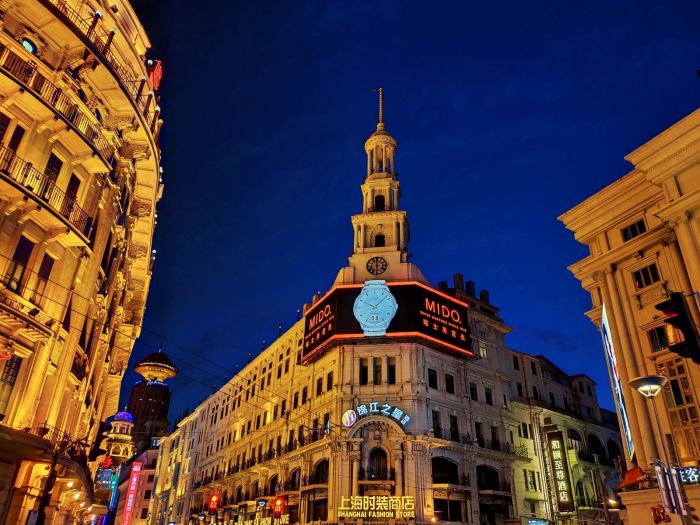Chinese Name: 南京路 Pronunciation: Nán Jīng Lù
Street Length: About 5.5 kilometers (about 3.4 miles)
Building Time: 1860
Building Function: Business Area
Admission Ticket Fare: Free
Opening Hours: All day
Suggested Visiting Hours: 1-3 Hours
Best Visiting Time: All year round
Popular Activities: Exploring different style architectures and various stores, eating special snacks and local foods, seeing the night-view, and taking the old style “Dangdang” Tram.
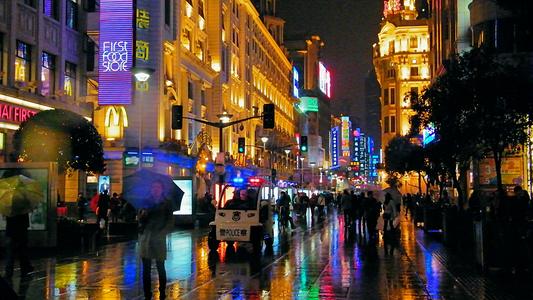
Nanjing Road is a street of about 5.5 kilometers long, with modern buildings mixed with European old buildings. Various shops lined in both side of the street, the lights of which are shining in the night. Visitors can take a small version of the old tram which is called "Dangdang tram" to discover the flavor of old Shanghai.
Divided by the Tibet Middle Road, Nanjing Road consists of two sections, the East Nanjing Road and West Nanjing Road. The Nanjing Road starts from Tibet Middle Road in the West and reaches Henan Middle Road in the East, with a dark red marble tablet at both ends. Creative city sculptures, fancy street lamps, flower beds and telephone booths are scattered in the street. In addition, there are a lot of chairs set in the middle of the street for tourists to have rest when tired.
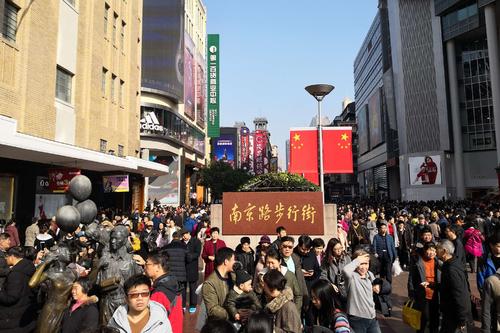
Nanjing Road is one of the busiest commercial streets in Shanghai, which has been the gathering place for department stores since early twentieth Century. Nowadays, there are not only old department stores such as Yong’an Department Store, BHG Mall, Silk Mall, but also large shopping centers such as New World City, Bailian World Trade International Plaza, Land Plaza, Hengji Celebrity Shopping Center and Hongyi Plaza. Customers can buy almost any commodity here, including luxuries and exclusive private customization.
Nanjing Road is also a paradise for delicious food. The shopping centers here have all kinds of fashionable restaurants, coffee shops, restaurants and food stores, such as Old Keller’s Restaurant, Dexing Pavilion, Cuiting Restaurant, and Shen Dacheng’s Dim Sum Shop.
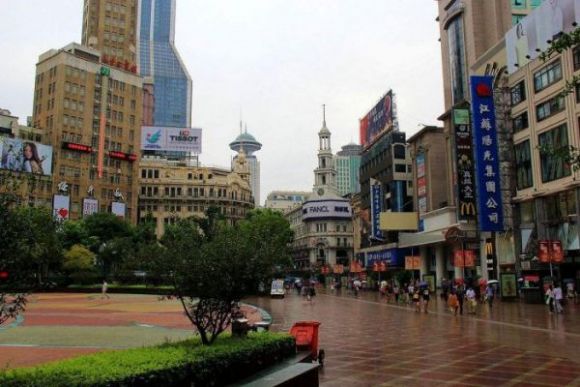
There are also some famous hotels on Nanjing Road, such as Changjiang Hotel, in which Chiang Kai Shek and Song Meiling got married in 1927.
Go along the Nanjing East Road to the Bund, where you can get view of the Huangpu River, the Bell Tower, The Oriental Pearl TV Tower, the Jinmao Tower, and Shanghai World Financial Center, etc.
After the Opium War in 1840, Shanghai was forced to become a trade port. The area of Nanjing Road first became one of the British concession areas, and then became a public concession. Nanjing Road is the first commercial street established after the opening of Shanghai port.
In 1945, after the National Government recovered all the concessions from the foreign powers, Nanjing Road was renamed as Nanjing East Road and Jingan Temple Road was renamed as Nanjing West Road. Therefore, Nanjing Road includes two of the ten major commercial centers in Shanghai: Nanjing East Road (including Nanjing Road Pedestrian Street) and Nanjing West Road (including the Jing’an Temple area).
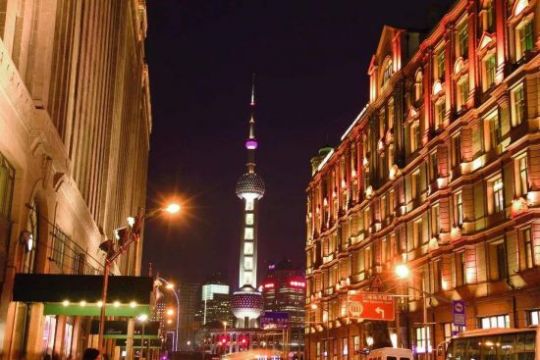
In 1850, the first racetrack in Shanghai was built near Lihua Department Store in Nanjing East Road by several foreign business men of Linrui Yanghang (foreign company). At the same time, a path leading to the Bund was built. Because foreigners rode horses on this path, the local people called the path “Malu”, which meant the road of riding horses. According to its pronunciation, Shanghai people called it Pake Nong(弄) in Shanghai dialect.
Nanjing West Road originated from Jing'an Temple was first built in the 1860s. In 1862, in order to facilitate the army's reach to the front line against the Taiping Army, the concession government extended Huayuannong (now named Nanjing East Road) westward, passing through Nichengbang (which is the concession boundary in 1860s, now called Tibet Middle Road), leading to Jing'an Temple, and connecting with Xujiahui Road (later called Meige Road, now named Huashan Road). The extended road is named Yongquan Road , also known as Jing'an Temple Road.
Most sections of Nanjing West Road still maintain the road width of about 20 meters (21.9 yard) as in the concession era, with good greening. Only a small section between Xikang Road and Tongren Road was widened when the Sino Soviet Friendship Building (now called Shanghai Exhibition Hall) was built in 1954, and Color sidewalk slabs were laid in this section.
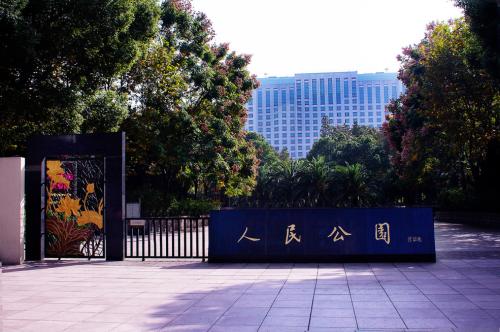
The east end is the People's Park, which was reconstructed from Horse Tacing Hall, and the west end is Jing'an Park, which was reconstructed from Wanguo Cemetery. Although Yan'an viaduct has been built in the south, it is still one of the east-west traffic arteries in Shanghai, with more than 20 bus lines passing through it. There are various institutions on both sides of the road, which is also a part of the culture.
Generally speaking, Nanjing Road was only a section from the Bund to the Park Lane (on Henan Road) in 1851, which stretched to Zhejiang Road in 1854( known as Damalu),and extended to Tibet Road in 1862. In 1865, the Shanghai Bureau of Public Concession and Industry officially named the whole extended road “Nanjing Road”.
From 1905 to 1911, a Jewish named Hutong paved the hardwood road on Nanjing Road. In March 1908, tram was established on the road. In 1945, the Shanghai municipal government of the Republic of China changed the name of Nanjing Road to Nanjing East Road, and the former Jing'an Temple Road to Nanjing West Road, which together known as Nanjing Road, with a total length of about 5 km.
In 1953, the hardwoods were removed, and concrete pavement was paved in Nanjing East Road by the government of the People’s Republic of China.
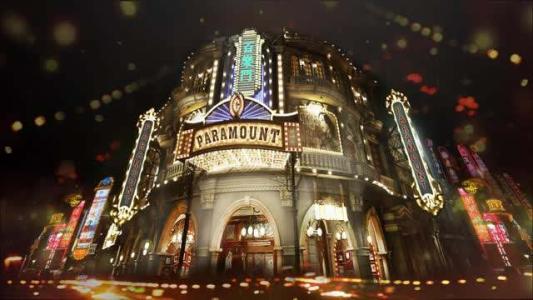
In 1932, Gu Liancheng, a Chinese businessman, invested 700,000 liangs (a Chinese unit of weight, 1 liang = 50 grams) of silver to purchase the land of Jing'an Temple to build Pramount Hall (now 218 Yuyuan Road), which was named "Bailemen" by homophony, and opened in 1933. Known as the No.1 music house in the Far East, Bailemen dance hall was a famous comprehensive entertainment place in Shanghai, which was available almost only to the top celebrities, such as Chiang Kai Shek and his wife, Kong family, Dai Li, Du Yuesheng, comedian Chaplin, Chinese richest man Rong Zongjing, Sasson(the richest man of the Far East), He Dong ( Hong Kong's richest man who settled in Shanghai at that time), Ruan Lingyu(famous actress), Hu Die(famous actress), Zhang Ailing(famous writer), and Huang Jinrong(gang leader) etc.
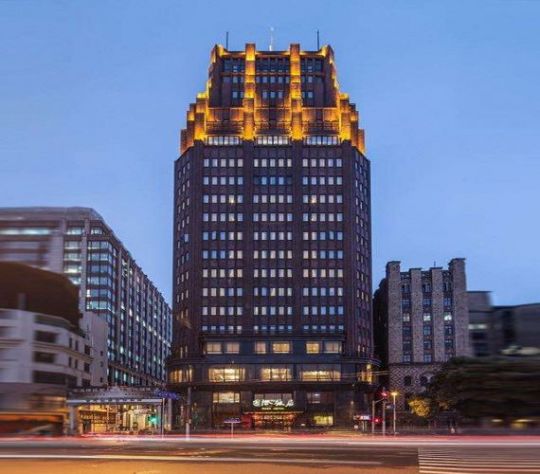
Located at No. 170, West Nanjing Road, the significance of Park Hotel is not that it had maintained its reputation as the tallest building in the Far East for decades in the past, but this tallest building was invested by a group of Chinese bankers and completed by the Chinese construction company. As the headquarters building of the four major banks in the north of China, at that time, its style exceeded almost all the foreign bank buildings except the global headquarters of HSBC at No. 12 on the Bund. Therefore, under the special historical background, the ambition and self-confidence of the Chinese people are greatly enhanced after completing the building.
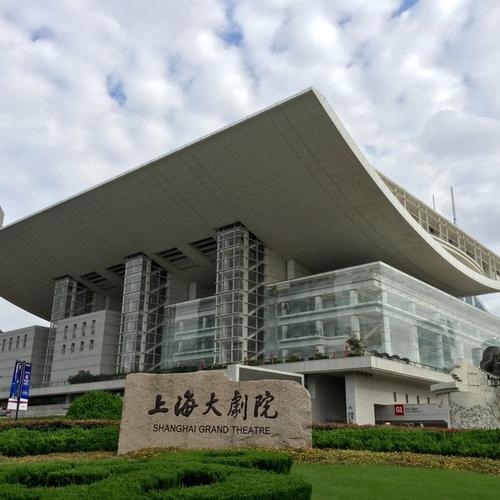
Located at No. 216, West Nanjing Road, first built in 1928, designed by a famous Hungarian designer Laszlo Hudec and rebuilt in 1933, co-invested by a Chinese business man Gao Yongqing and American man Albert Wanner, Grand Theater was no doubt the No. 1 film theater in China for decades. The theater created countless firsts in Asian and Chinese film field, such as Asia's first cinema with air conditioning system, Asia's first stereo cinema, Asia's first audio film (Asia's first silent film was played in a coffee shop in Shanghai in the late 19th century), Asia's first dubbing film, China's first wide screen film, and the first place to hold the ceremony of China's first international class film festival (Shanghai Film Festival).
Grand Theater was one of the top eight premiere cinemas in the world designated by Hollywood, and which was also the only designated one in Asia at that time. This also led to a large number of Japanese rich people from Tokyo by boat or even by plane to come to Shanghai to watch films whenever blockbuster was on. In addition, at that time, the most top symphony orchestra in Asia, the Municipal Orchestra, was stationed here, and almost all the Asian premieres of world-famous music were held here.
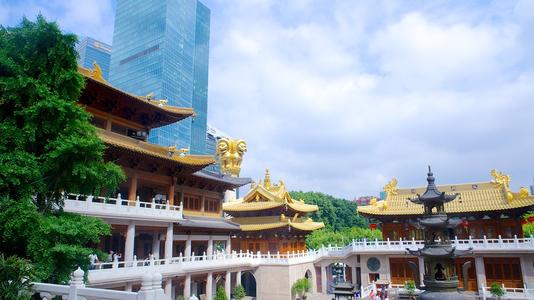
Located at No. 1686 West Nanjing Road, Jing'an Temple is one of the famous ancient temples in Shanghai, which was called Chongyuan temple and Chongyun temple in history. It is said that Jing'an Temple was first built in the Three Kingdom Period (220-280 A.D.). In 1008, the temple changed its name to Jing'an Temple. In 1216, in the Southern Song Dynasty, the temple was moved from the Wusong River to Feijingbang (now No. 1686 West Nanjing Road). At the end of Qing Dynasty, the temple became the present scale. In 1945, Deng Sanmu, a calligrapher, autographed "Jing'an ancient temple" on the plaque, which has been used up to now.
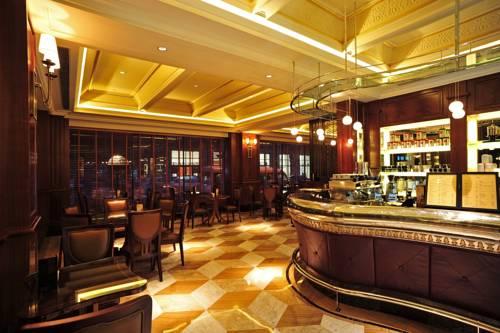
Located at No. 20 East Nanjing Road, Peace Hotel is a landmark in Shanghai, which is also the first modern building in the history of modern architecture in Shanghai. It has the most distinctive nine national style suites and many distinctive restaurants, banquet halls, multi-function halls, bars, roof sightseeing gardens, etc.
Opened in 1919, Shanghai Peace Hotel has a history of more than a hundred years, which was redecorated in 1999 and officially listed as 5 stars in 2000. The hotel has two buildings, one building is 11 stories tall, and the other building is six stories high.
Take Bus No.20, No.37, No.330, No.921, and get off at the stop of "People's Square", walk towards east for about 100m, then go through the sinking square tunnel and reach the western starting point of the pedestrian street.
Take bus of City Tourism Line 1, and get off at the stop of “New World City”(新世界城 Xīn Shì Jiè Chéng), or get off at the stop of “Middle Henan Road”(河南中路Hé Nán Zhōng Lù).
By Subway
Take Metro Line 1, or Line 2, or Line 8 to the "People's Square" station (人民广场 Rén Mín Guǎng Chǎng), and get out from the Exit 6, then go through the sinking square tunnel and reach the western starting point of the pedestrian street.
Take Metro Line 2 or Line10 to "Nanjing East Road" station (南京东路 Nán Jīng Dōng Lù), and get out from Exit 1, or 2 or 4, and reach the eastern starting point of the pedestrian street.
By Taxi
Chinese: 请带我去南京路。English: Please take me to Nanjing Road.
If you go to the Nanjing Road from Pudong International Airport, it takes about 1 hour (45 km, about 160 yuan).
If you go to the Nanjing Road from the Shanghai Railway Station, it takes about 15 minutes (4 km, about 20 yuan).
If you go to the Nanjing Road from the Shanghai South Railway Station, it takes about 35 minutes (16.3 km, about 50 yuan).
